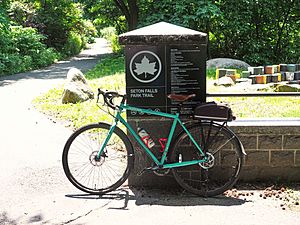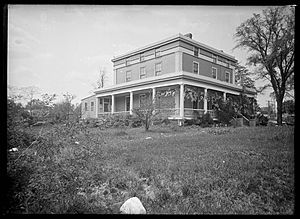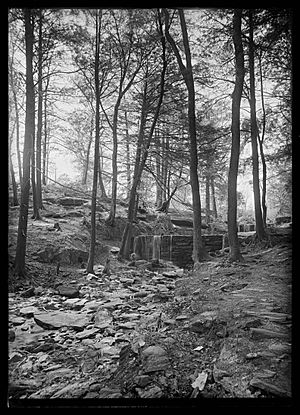Seton Falls Park facts for kids
Quick facts for kids Seton Falls Park |
|
|---|---|

Entrance to Seton Falls Park
|
|
| Location | The Bronx, New York, United States |
| Area | 35 acres (14 ha) |
| Authorized | June 11, 1930 |
| Owned by | NYC Parks |
| Hiking trails | yes |
| Terrain | wooded |
| Connecting transport | Bus: Bx16, Bx30 Subway: 5 train at Eastchester–Dyre Avenue |
| Website | https://www.nycgovparks.org/parks/seton-falls-park |
Seton Falls Park is a beautiful, wooded park in The Bronx, New York City. It covers about 36 acres, which is a lot of space for nature and fun! The park is named after the Seton family, who owned this land back in the 1800s. A famous person from this family was Elizabeth Ann Seton, who became a saint.
You can find Seton Falls Park in the Edenwald area, near where East 233rd Street and Baychester Avenue meet. The park has playgrounds and sports fields for you to enjoy. It's also home to a special part of a small creek called Rattlesnake Brook. This is the only place where you can see the creek flowing above ground!
Long ago, the Siwanoy Native American tribe lived on this land. Later, different families owned the area, including an ancestor of the Roosevelt family. The Seton family got the land through marriage. In 1894, New York City took over the land. By 1930, it was officially made a park. The New York City Department of Parks and Recreation (NYC Parks) then added fun things like playgrounds. After some time when the park needed fixing, it was made new again.
Contents
Exploring Seton Falls Park
This park is managed by the New York City Department of Parks and Recreation (NYC Parks). It's located in the northeast Bronx, close to the border with Mount Vernon, New York. The park is surrounded by streets like East 233rd Street, Baychester Avenue, and Crawford Avenue. There are also schools nearby, like the former John Philip Sousa School. You can even get there by subway, as it's close to the Eastchester–Dyre Avenue station.
Nature and Wildlife
A small creek called Rattlesnake Brook flows through the park. Most of this creek is now underground, but the part in Seton Falls Park is the only section you can see. The brook even has a waterfall inside the park! While the brook is natural, the waterfall was actually built by people. There are paths where you can walk along the creek.
Seton Falls Park is a special place for nature, with a wildlife preserve. More than 30 types of birds live here! You can also find marshy areas with tall plants called cattails, grassy meadows, and forests along the creek. Higher up in the park, there are forests with oak and hickory trees. Keep an eye out for frogs, turtles, and different kinds of ducks and geese too!
Fun Things to Do
Seton Falls Park has two great playgrounds. At the northwest side, you'll find High Rock Playground. At the southwest side, there's Stars & Stripes Playground. This one has handball courts and basketball courts, plus a play area for kids. It's looked after by both NYC Parks and the New York City Department of Education. In the past, there was even a baseball field here.
Park History
Early Days of the Land
Before it was a park, this area had many oak, chestnut, hickory, and walnut trees. The Siwanoy Native American tribe lived here and used caves and other spots. In 1654, a man named Thomas Pell bought the land. Later, in 1696, his nephew Sir John Pell was allowed to build a mill on Rattlesnake Brook. During the American Revolutionary War in 1781, there was a small fight between British and American soldiers in what is now the park. By 1790, many of the trees had been cut down.
After the Revolutionary War, the land was owned by different people. In 1835, a banker named Nathaniel Prime got the land. He gave it to his daughter Emily, who married William Seton, the son of Saint Elizabeth Ann Seton. Their home on the estate was called The Cedars, and later Cragdon, because of all the red cedar trees. William Seton cut down many trees and built a dam on Rattlesnake Creek, which created two ponds and a waterfall. The big house on the estate was said to be similar to Hamilton Grange, the old home of Alexander Hamilton.
William and Emily Seton had six children, but they moved away by 1860. For many years, the estate was rented out and sometimes had problems with theft. By 1905, new oak and elm trees had been planted. A storm in 1900 destroyed Seton's mill, but the waterfall remained. It was described as a 30-foot drop with two separate falls.
Becoming a Park
New York City took over the parkland and nearby areas in 1894. The Seton estate was divided into smaller pieces. In 1914, the city decided to buy the Seton estate to build a hospital. They bought about 32 to 33 acres of land. But people living nearby didn't want a hospital there. So, after trying for 15 years, the city changed its mind. On June 11, 1930, the land was officially given to NYC Parks to become a park! A few more acres were added in 1932.
NYC Parks then started adding things like fountains, benches, and a baseball field to Seton Falls Park. Rattlesnake Creek was put into a stone channel, and the two ponds were filled in. Maps from NYC Parks showed that the trees from the late 1800s had grown into a big, old forest. In 1941, Robert Moses, a famous parks commissioner, wanted to make the park even bigger. Some land was bought for this, but it was used to build a school, JHS 142, which opened around 1958. The Stars & Stripes Playground next to it opened in 1961.
Park Improvements and Care
As more people moved to the northeast Bronx, the park was used more, and some parts started to wear out. By 1970, Seton Falls Park was in bad shape. Trash blocked Rattlesnake Creek, and there was a lot of damage. In 1973, a pipe that carried the creek water out of the park broke. This caused water to back up and create a swamp, which killed trees along the creek. The city thought about fixing the park in 1974, but money problems in New York City delayed the plans. This led to even more problems, including people dumping garbage.
Plans to fix Seton Falls Park started in 1978. NYC Parks found a way to fix it for less money than first thought. The first part of the fix was done in 1981. This included moving Rattlesnake Creek into the city's sewer system. A broken sewer line under the creek's broken pipe was also fixed. In 1983 and 1985, NYC Parks got more land around the school so a fence could be built around the park's forest. The second part of the park's rebuilding started in 1986. Peter Dunleavy, who designed the park's new look, even won an award for his work!
In 1990, NYC Parks announced they would fix up 24 acres of the park. By the mid-1990s, the park was not used much. A basketball player, Charles Oakley, suggested making it more for sports. But a community leader named Christine Foreman wanted to clean up the park instead. She started a group called the Seton Falls Park Preservation Coalition. With help from NYC Parks, they got money to fix the park. Seton Falls Park was restored between 2007 and 2008. The money came from a fund related to building the Croton Water Filtration Plant. This helped fix trails and other parts of the park. However, it again needed some care a few years later.
In recent years, the park has been used for fun activities like park ranger tours, outdoor movie nights, and even protests. Volunteers also help remove plants that don't belong there. In 2018, there was an idea to build a skate park in Seton Falls Park.
Images for kids





